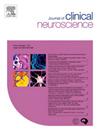蛛网膜下腔出血增强脑脊液清除:脑室和腰椎联合引流的系统回顾
IF 1.8
4区 医学
Q3 CLINICAL NEUROLOGY
引用次数: 0
摘要
动脉瘤性蛛网膜下腔出血(aSAH)是一种严重的卒中类型,具有高死亡率和发病率。aSAH的两个主要并发症是急性脑积水和由严重血管痉挛引起的延迟性脑缺血(DCI)。虽然脑室外引流和腰椎引流(LD)通常单独用于治疗脑积水,但它们联合使用在降低血管痉挛风险方面的潜在益处仍未得到充分探讨。方法系统检索PubMed/MEDLINE和Scopus数据库,寻找重度asah -脑积水患者双引流系统的相关研究。搜索算法检索了1341个结果。在排除阶段结束时,我们将4项研究纳入最终分析。结果148例asah后脑积水患者采用双脑脊液引流治疗。约2/3的患者接受了治疗,大多数患者进行了血管内修复。LD通常放置在早期,尽管时间协议各不相同。平均维持引流0.5 ~ 16天,以持续引流居多。并发症发生率各不相同:经临床或血管造影评估,18.9%的患者出现缺血,而22.3%的患者出现血管痉挛。脑脊液感染的病例高达31.6%。功能结果总体上是有利的,随访时mRS平均评分从1.0到2.4不等,这取决于最初的临床严重程度。结论双脑脊液引流对aSAH患者有一定的疗效,特别是对大出血患者。初步数据表明,它可以通过增强脑脊液清除率来减少血管痉挛并改善预后。然而,证据仍然受到研究可变性和缺乏直接比较的限制。在更多的数据出现之前,双重引流应保留给高危患者。本文章由计算机程序翻译,如有差异,请以英文原文为准。
Enhancing cerebrospinal fluid clearance in subarachnoid hemorrhage: A systematic review of combined ventricular and lumbar drainage
Introduction
Aneurysmal subarachnoid hemorrhage (aSAH) is a severe type of stroke associated with high rates of mortality and morbidity. Two major complications following aSAH are acute hydrocephalus and delayed cerebral ischemia (DCI) caused by severe vasospasm. While external ventricular drainage and lumbar drainage (LD) are typically used separately to manage hydrocephalus, the potential benefit of their combined use in reducing vasospasm risk remains underexplored.
Methods
We conducted a systematic search on PubMed/MEDLINE and Scopus databases to identify relevant studies discussing double drainage systems in patients with severe aSAH-hydrocephalus. The search algorithm retrieved 1341 results. At the end of the exclusion phase, we included 4 studies in the final analysis.
Results
We included 148 patients with post-aSAH hydrocephalus treated using dual CSF drainage. Treatment was reported in about 2/3 of patients and endovascular repair was in most of them. LD was typically placed early, though timing protocols varied. Drainage was maintained on average 0.5–16 days, with continuous drainage being most common. Complication rates varied: ischemia was reported in 18.9 % of patients, while vasospasm occurred in 22.3 % of cases when assessed clinically or angiographically. CSF infection was reported in up to 31.6 % of cases. Functional outcomes were generally favorable, with mean mRS scores at follow-up ranging from 1.0 to 2.4, depending on initial clinical severity.
Conclusion
Patients with aSAH may benefit of dual CSF drainage, especially in case of massive bleeding. Preliminary data suggest that it may reduce vasospasm and improve outcomes by enhancing CSF clearance. However, the evidence is still limited by study variability and lack of direct comparisons. Until more data emerge, dual drainage should be reserved for high-risk patients.
求助全文
通过发布文献求助,成功后即可免费获取论文全文。
去求助
来源期刊

Journal of Clinical Neuroscience
医学-临床神经学
CiteScore
4.50
自引率
0.00%
发文量
402
审稿时长
40 days
期刊介绍:
This International journal, Journal of Clinical Neuroscience, publishes articles on clinical neurosurgery and neurology and the related neurosciences such as neuro-pathology, neuro-radiology, neuro-ophthalmology and neuro-physiology.
The journal has a broad International perspective, and emphasises the advances occurring in Asia, the Pacific Rim region, Europe and North America. The Journal acts as a focus for publication of major clinical and laboratory research, as well as publishing solicited manuscripts on specific subjects from experts, case reports and other information of interest to clinicians working in the clinical neurosciences.
 求助内容:
求助内容: 应助结果提醒方式:
应助结果提醒方式:


